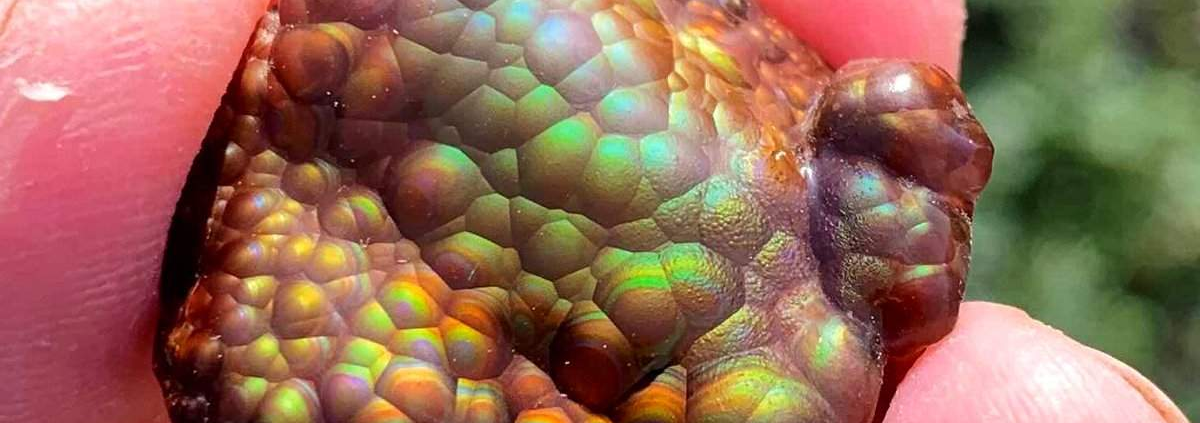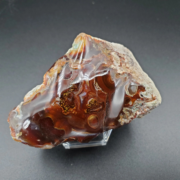What is Fire Agate? Discovery, Properties, and Origins
Fire agate is a semi-precious gemstone known for its captivating play of colors, similar to opals but with a more earthy appearance. It is a variety of chalcedony, a mineral in the quartz family, and is typically found in hues of deep red, orange, brown, and gold. The vibrant, iridescent flashes seen in fire agate are due to the presence of layers of limonite or iron oxide within the stone.

This gemstone is primarily found in Mexico and the southwestern United States, particularly in regions of volcanic activity. Its mesmerizing, fiery appearance makes it popular in jewelry, and it’s also considered a stone for protection, grounding, and enhancing creativity in metaphysical traditions.
Contents
- Discovery
- Properties
- Origins
- 1. Geological Formation:
- 2. Main Sources:
- 3. Age:
Discovery
Fire agate was discovered in the mid-20th century, primarily in the southwestern United States and northern Mexico, regions rich in volcanic activity. The stone forms in layers within cavities of volcanic rocks, particularly in areas where ancient hydrothermal activity occurred.

The first notable deposits of fire agate were found in Arizona and California, particularly in areas like the Black Hills of Arizona and the Calico Mountains in California. Mexico’s Sierra Madre Occidental mountain range is also home to significant fire agate deposits, particularly in areas around the states of Chihuahua and San Luis Potosí.
The discovery of fire agate is relatively recent compared to other gemstones like diamonds or emeralds, and its unique, vibrant color patterns made it a quick favorite among gem collectors and jewelry makers. Since its discovery, fire agate has remained relatively rare and is considered a specialty stone, particularly prized for its vivid iridescent colors and intricate internal patterns.
Properties
Fire agate, like other minerals, has several key scientific properties that make it unique. These properties are primarily physical and chemical characteristics:
 Fire Agate
Fire Agate
1. Chemical Composition:
Fire agate is a variety of chalcedony, which is a form of microcrystalline quartz. Its chemical formula is SiO₂ (silicon dioxide).
2. Formation Process:
Fire agate forms in the cavities of volcanic rocks through hydrothermal activity. Over millions of years, silica-rich solutions deposit layers of chalcedony, sometimes incorporating iron oxides like limonite, which contribute to its vibrant colors.
3. Color and Appearance:
The gemstone has a distinct iridescent or rainbow-like appearance due to interference patterns in the layers of the stone. These layers trap light, producing the “fire” effect with colors such as red, orange, yellow, and green. This phenomenon is similar to the play of colors in opal, though fire agate’s color play is more structured and localized.
4. Hardness:
On the Mohs scale of hardness, fire agate ranges between 6.5 and 7. This makes it a relatively hard gemstone, suitable for use in jewelry.
5. Crystal Structure:
Like all chalcedony varieties, fire agate is composed of tiny fibrous crystals of quartz, arranged in a trigonal crystal system.
6. Refractive Index:
The refractive index of fire agate typically ranges between 1.53 and 1.54, contributing to its light refraction properties, which enhance its brilliance and fire.
7. Specific Gravity:
Fire agate has a specific gravity of approximately 2.59 to 2.61, which is typical for quartz-based minerals.
8. Fracture:
Fire agate exhibits a conchoidal fracture, meaning it breaks in a curved, shell-like pattern, which is characteristic of quartz-based minerals.
These properties are what give fire agate its unique visual appeal and make it suitable for various uses, especially in jewelry. Its hardness and vibrant colors allow it to be cut, polished, and set into different types of accessories.
Origins
Fire agate originates primarily from volcanic regions in the southwestern United States and northern Mexico. Its formation is tied to ancient volcanic activity and the hydrothermal processes that occurred in these areas millions of years ago.

1. Geological Formation:
- Volcanic Activity: Fire agate forms in cavities or voids within volcanic rock, particularly rhyolite and andesite. These cavities were filled with hot, silica-rich water during volcanic activity. Over time, as the water cooled, layers of silica (chalcedony) were deposited.
- Hydrothermal Process: The formation of fire agate occurs over thousands to millions of years as minerals like iron oxide (limonite) and silica crystallize layer by layer. The internal iridescence, or “fire,” is due to these fine layers of minerals, which interfere with light and create the vibrant colors.
2. Main Sources:
- United States: Some of the most important fire agate deposits are found in the southwestern U.S., particularly in:
- Arizona (notably in the Black Hills, near the town of Safford)
- California (Calico Mountains)
- New Mexico
- Mexico: The northern part of Mexico, especially in the Sierra Madre Occidental mountain range, has yielded substantial deposits of fire agate. States like Chihuahua and San Luis Potosí are well-known sources.
3. Age:
- The volcanic activity responsible for fire agate formation took place during the Tertiary period, approximately 24 to 35 million years ago. During this time, the region experienced extensive volcanic events, creating the perfect conditions for fire agate’s development.
These volcanic origins, combined with the stone’s unique internal structure, give fire agate its vibrant, fiery colors and make it a rare and sought-after gemstone. Its formation in remote, geologically active regions explains its relative scarcity and value.




Leave a Reply
Want to join the discussion?Feel free to contribute!